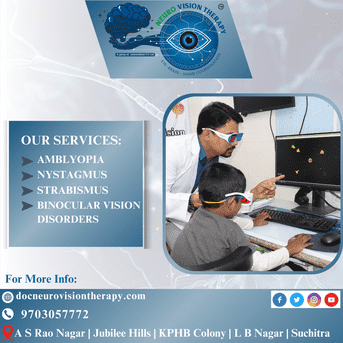
The goals of vision therapy are to reduce the amplitude of involuntary eye movements, improve tracking abilities, and enhance visual stability.
Nystagmus is a vision condition characterized by rapid, involuntary, and repetitive eye movements. These movements can occur horizontally, vertically, or in a rotary (circular) pattern. Nystagmus can affect one or both eyes and may be present from birth (congenital) or develop later in life (acquired).
Nystagmus can result in reduced vision, depth perception, and balance, depending on its severity and associated conditions.
Neuro Vision Therapy aims to improve visual function and quality of life for individuals living with nystagmus.
Vision Therapy Techniques for Nystagmus
Saccadic eye exercises: These are exercises designed to help improve the ability of the eyes to quickly and accurately shift focus from one target to another. This is useful in nystagmus, as it can help reduce the extent of involuntary eye movements.
Pursuit training: This type of exercise improves smooth tracking of moving objects, which can be affected by nystagmus. Patients practice following moving objects with their eyes without their eyes jumping or making erratic movements.
Enhanced fixation stability: Vision therapy may include exercises that help patients maintain stable visual fixation on an object for extended periods. This can help stabilize the gaze and reduce the involuntary eye movements typical of nystagmus.
Use of special tools: Some therapists may use tools like visual targets, prisms, or light boards to help with focusing and tracking, guiding patients to maintain their gaze longer without the involuntary movement.
In cases where nystagmus affects both eyes and leads to problems with depth perception and eye coordination, exercises aimed at improving binocular vision (the ability to use both eyes together) can help. This may include exercises that encourage better eye teaming or reduce double vision.
Some therapy techniques focus on improving a patient’s ability to adapt to different lighting and visual conditions, which may help reduce the symptoms of nystagmus, especially in low-vision settings. For example, visual training in dim or bright conditions might be used to help people with nystagmus adapt more comfortably to varying environments.
Symptoms
Vision therapy for nystagmus involves a range of specialized exercises and techniques aimed at improving eye coordination, visual stability, and overall eye function. The therapy typically focuses on helping individuals with nystagmus better control involuntary eye movements and enhance their ability to focus and track objects.
Comprehensive Evaluation: Our experts conduct thorough eye examinations to assess the extent of the problem and its impact on vision. We utilize specialized tests to determine the underlying causes and tailor treatment plans accordingly.
Customized Treatment Plans: Based on the individual’s age, severity and associated vision problems, we design personalized treatment strategies. These may include corrective lenses, eye exercises aimed at realigning the eyes.
Post-operative Care and Rehabilitation: Following interventions, our team provides comprehensive postoperative care and guidance to facilitate optimal recovery and rehabilitation. We work closely with patients to monitor progress and address any concerns throughout the treatment process.
Patient-Centered Approach: At Ashoka, we prioritize patient comfort, safety, and satisfaction. Our compassionate team ensures that individuals feel supported and informed at every stage of their treatment journey, fostering trust and confidence in the care they receive.
Goal
The goals of vision therapy are to reduce the amplitude of involuntary eye movements, improve tracking abilities, and enhance visual stability. While the effectiveness of vision therapy can vary depending on the severity and underlying causes of nystagmus, it can significantly improve the quality of life by reducing symptoms such as dizziness and blurred vision, and helping with daily activities like reading or navigating environments.
© 2024 Crivva - Business Promotion. All rights reserved.